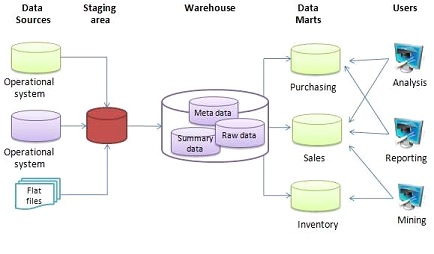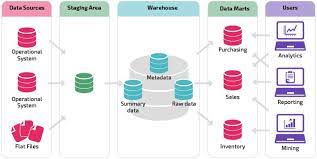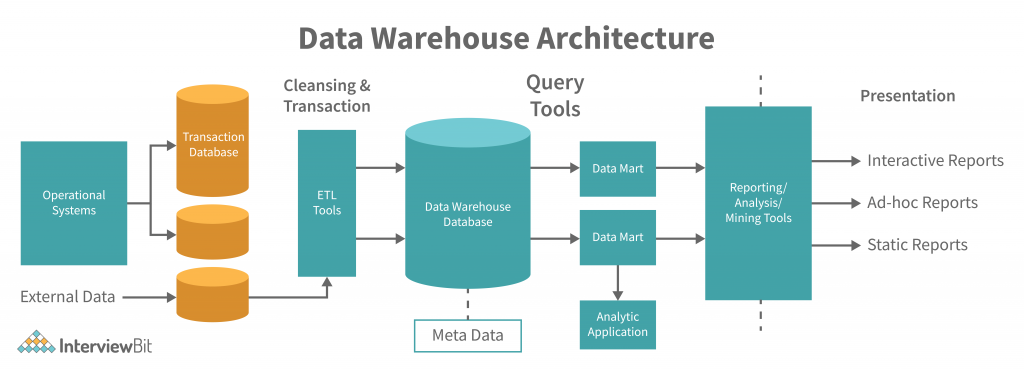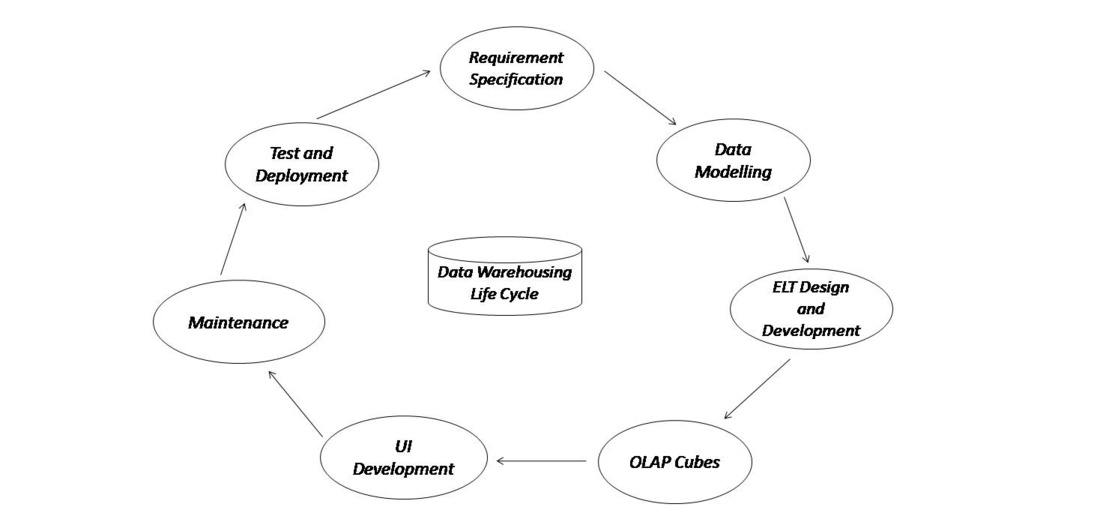This article was published as a part of the Data Science Blogathon.
Introduction
The purpose of a data warehouse is to combine multiple sources to generate different insights that help companies make better decisions and forecasting. It consists of historical and commutative data from single or multiple sources. Most data scientists, big data analysts, and business analysts use a data warehouse to get their data. This data warehouse can store data from multiple sources, including internal devices. Data is checked and cleaned before each upload. Now let us jump into the world of the data warehouse.
What might be Data Warehousing?
Data Warehouses are a place to store our data. To make better decisions, the data used in the past and the data that will be useful in the future are stored in a Data Warehouse. A Data Warehouse would consist of all raw data used or related to the organization/company. It was constructed by integrating multiple heterogeneous sources of data. Every company’s most valuable asset is information. This information is used for operational record keeping and analytical decision-making.
Operational Databases might change over time. If a company/organization wants to analyze previous actions or profits on data, it may not find data as previous data would have been updated. In this scenario, Data Warehouse comes into the picture. A data warehouse would consist of all the data related to an organization from which we can get our data. It helps in the integration of a diversity of application systems.
A data warehouse is a data management system that facilitates and supports business intelligence (BI) activities and analysis. These are primarily designed to contain large amounts of historical data and to analyze the searches. Unlike operational databases, warehouses are not updated frequently.
Importance of Data Warehouse
- They extract data from several sources and process it through ETL (Extract, Transform and Load) to load data into the data warehouse.
- Data Warehouses improves the speed and efficiency of accessing different datasets and helps decision-makers to derive insights that will guide them to be apart from their competitors.
- Data Warehouse is highly scalable and efficient, enhancing data conformity and quality.
- Data Warehouse is a single source for all the data in the organization/company.
- A data warehouse platform allows business leaders to access their organization’s past activities and assess past initiatives’ successes or failures. This helps executives to see where they can reduce costs, maximize efficiency, and increase sales to boost profit.
The goals of Data Warehouse / BI systems would be:
- Data Warehouse / BI systems must make systems easily accessible.
- Data Warehouse / BI systems must present information consistently.
- These systems must adapt to change.
- Data Warehouse / BI systems must present information promptly.
- Systems must be secure bastion that protects the information assets.
- They should work as authoritative and trustworthy for improved decision-making.
For better understanding, we can divide any data warehouse into 4 stages of the process.

1. Collect – At the collect stage, we fetch the raw data from the source systems and store the data in a layer named the staging layer. This process is called ETL (Extract, Transform and Load data). There are various tools to enable ETL for the data warehouse.
2. Store – We are preparing to store data for our present or future information analysis in operational databases or in some other source.
3. Analyze – Structuring the raw data into an understandable format helps business analysts or decision-makers to get insights from various analyses and visualizations of the data.
4. Consume – At this stage, various tools like Power BI and Hadoop are available to help explore data in detail.
All these stages tell us the structure or process of the data warehouse.
Characteristics of the Data Warehouse
1. Integrated: Data warehouses are built by integrating data from disparate sources such as relational databases and flat files. This integration enhances effective data analysis. Data must be stored consistently and universally acceptable in a warehouse.
2. Nonvolatile: No matter what data it is, it does not change once it enters the warehouse or is not removed from it. Operational and data warehouses are kept separate. So, the frequent changes in the operational database are not reflected in the data warehouse.
3. Subject Oriented: Data Warehouses are subject-oriented because they provide information about topics rather than ongoing operations in an organization. Topics may be products, suppliers, customers, etc. A data warehouse concentrates on modeling and analyzing data for decision-making rather than performing day-to-day operations
4. Time Variant: Information acquired from the data warehouse is identified by a specific period. The data warehouse would contain information on historical trends.
The Architecture of the Data Warehouse

There are 3 approaches for constructing a Data Warehouse architecture
- Single Tier
- Two-tier
- Three Tier
Single Tier Architecture
The main reason for this architecture is to minimize storage levels. The main goal of this architecture is to remove data redundancy.
Two Tier Architecture
It is also one of the Data Warehouse layers that separate physically available sources and the data warehouse. This architecture doesn’t support a large number of end-users, and it is also not expandable.
Three Tier Architecture
The most widely used architecture of the Data Warehouse consists of a top, middle, and bottom tier.
Bottom Tier
The bottom tier or data warehouse server usually represents a relational database system. To cleanse, transform and feed data into the layer, back-end tools are used.
Middle Tier
It represents an OLAP server that can be implemented in two ways
1. ROLAP 2. MOLAP
ROLAP (Relational Online Analytical Processing) servers are usually placed between the relational backend server and the client front-end server. It performs dynamic multidimensional data analysis and maps it to a standard relational process.
MOLAP (Multidimensional Online Analytical Processing) deals directly with multidimensional data and operations.
Top Tier
Top Tier is a client-side interface that gets data from the data warehouse. It consists of tools like query tools, analysis tools, reporting tools, and data mining tools.
Data Warehouse Components

1. Data Warehouse Database
The most significant component of the Data Warehouse is the database. It was implemented with RDBMS technology. However, this type of implementation is limited because traditional RDBMS systems are optimized for processing transactional databases and not for data warehouses. There are a few alternatives, like deploying RDBMS in parallel, which allows shared memory on various multiprocessor configurations, using new index structures to bypass relational table scans, etc. These are approaches to databases.
2. ETL (Extract, Transformation, and Loading Tools)
These tools are responsible for extracting data from various sources, transforming it into a digestible format, and loading it into the data warehouse. There are many functionalities like anonymizing data, eliminating unwanted data loading into the Data Warehouse, getting a summary, populating missing data with defaults, etc. In ETL tools. These tools can also generate background jobs, shell scripts, etc., that update data. These tools help maintain the metadata.
3. Metadata
Metadata is data that defines the data warehouse, which is used in building, maintaining, and managing data warehouses. It provides various frameworks enabling the above usages. These are the essential and critical ingredients in transforming data into knowledge.
Metadata can be classified into two categories.
Technical Meta Data: This contains information about the warehouse which is used by data warehouse designers and administrators.
Business Meta Data: This contains information that is easily understood by end users.
4. Data Warehouse Access / Query Tools
Access tools allow users to interact with the data warehouse system. These warehouse tools include query and reporting tools, data mining, OLAP, and application development tools.
These tools are divided into four different categories:
- Query and reporting tools
- Application Development tools
- Data mining tools
- OLAP tools
5. Data Warehouse Bus architecture
This architecture defines the data flow in a data warehousing system and includes a data mart in it. The data flow can be categorized as Up flow, Down flow, Outflow, and Meta flow.
6. Data Warehouse Reporting Layer
The reporting layer in the data warehouse allows the end user to access the business intelligence (BI) interface or BI database architecture. It acts as a dashboard for visualizing and creating reports and pulling out all the required information.
Data Marts
This is an access level that allows users to access or transfer data. It takes less time and money to build, so it is the most cost-effective option for large-size data warehouses. It is used as a partition of data that is created for a specific group of users.
Life Cycle of a Data Warehousing
Several steps must be followed in order to build a successful data warehouse with implementation.

The above diagram indicates the life cycle of data warehousing involving steps for the successful completion of data warehousing.
Latest Tools and Technologies in Data Warehousing
Data Warehousing helps businesses to get deep insights from even large amounts of data. It improved its access to information, reduced response time for queries, etc. Today, cloud technology has reduced the cost and effort to build infrastructure for data warehousing. There are various tools and technologies for data warehousing. Cloud-based data warehousing tools are fast, highly scalable, efficient, and available regularly. Some of the Data Warehousing tools are:
- Microsoft Azure
- Amazon Redshift
- Snowflake
- Google Big Query
- Micro Focus Vertica
- Amazon DynamoDB
- PostgreSQL
- Amazon s3
- Teradata
- Amazon RDS
- IBM Db2 Warehouse
- Oracle Autonomous Warehouse
- MariaDB
- MarkLogic
- Cloudera
These are some of the Data Warehousing tools.
Conclusion
For companies, data warehouses provide useful insights from their past data that can help make future decisions. This also helps companies to store a large amount of data and keep track of it. Some of the beneficial and summarized points would be
- Data Warehouse is a system that contains historical and commutative data from multiple sources. These sources can be Cloud Data Warehouse, Virtual Data Warehouse, or Traditional Data Warehouses.
- Data Warehouse is subject-oriented, non-volatile, and Time-variant.
- Data Warehouse metadata provides information regarding the data warehouse data’s source, usage, and features.
- Data Sourcing, transformation, and migration tools perform all conversions and summarizations.
The media shown in this article is not owned by Analytics Vidhya and is used at the Author’s discretion.




